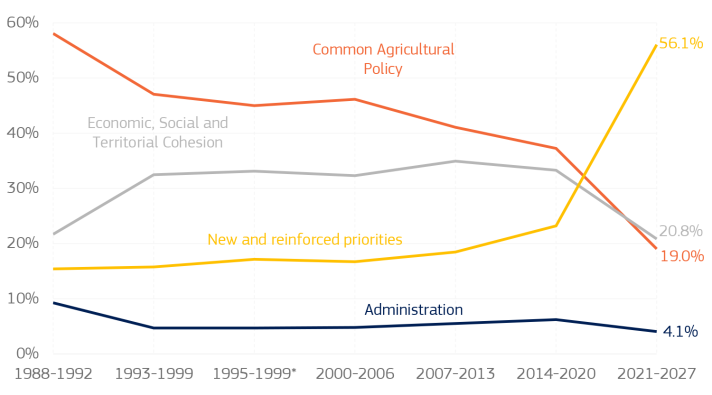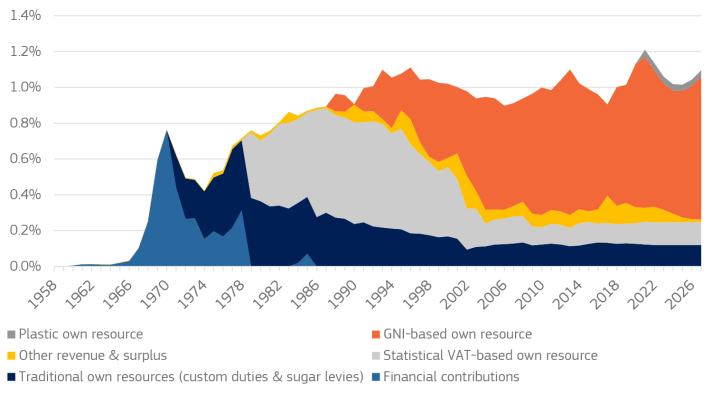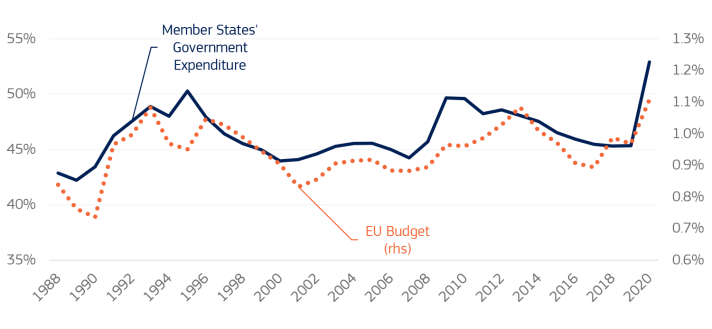The EU budget has gradually evolved in step with the European integration process. The separate budgets created with the European communities in the 1950s were merged in different steps and finally became a single budget only in the 2000s. As the competences of the EU grew, so did the scope of the EU budget. The below sections present four major parts of the EU budget evolution as well as some food for thought regarding the future.
Policies funded by the EU budget
Since the first major common policy – agriculture – in the 1960s the EU budget changed in parallel with the broadening of the scope of EU competences. This development happened progressively through several treaty changes.
Since 2000, the EU budget has been shaped by the arrival of 13 new Member States with diverse socioeconomic situations, which led to an increase in cohesion policy support. The EU budget has also accompanied the growing role of the Union in the international arena, as a leader in the fight against climate change and as the largest donor of humanitarian and development aid in the world.
What policies should be funded by the EU budget?

Share of the main policy areas in the MFFs (with NextGenerationEU)
Source: European Commission
Note: Data are based on the financial perspective/framework ceilings in commitment appropriations, current prices - including adjustments for enlargement, reprogramming for late adoption of national programmes and MFF annual technical adjustments, where applicable.
As the role of the EU changes, so do the types of policies the EU budget funds.
How can the EU budget focus on the policy areas and issues where the added value of EU action is the highest?
With the war in Ukraine and the challenges that have arisen, is the time right to extend the EU budget’s capabilities to actively promote Europe’s strategic autonomy?
EU Budget Policy Brief #1: The evolving nature of the EU budget
EU Budget Policy Brief #2: EU strategic autonomy and the role of the EU budget
EU budget revenue

Sources of financing of the EU budget, 1958-2018
Source: European Commission, AMECO
The composition of revenues to the EU budget has evolved considerably over time.
In the beginning, when the European Economic Community (the prelude of today’s European Union) was established, financing was similar to those of most international organisations – by direct financial contributions paid in by the Member States.
As the integration between Member States advanced, the need for genuine own resources grew. In 1962, after the establishment of the Common Agricultural Policy, it was decided that levies on the import of agricultural goods from the outside would accrue to the common budget.
The first Own Resources Decision was adopted by the Council in 1970, and established agricultural levies and custom duties as the basis for the financing of the EU budget - they later became known as "traditional own resources".
Today, about 80% of the EU budget is financed from national contributions based on GNI and VAT. In addition, custom revenues, considered a genuine own resources as they are derived from the common trade policy whose revenue accrue to the EU budget, account for roughly 10% of the EU budget. As of 2021, the first new own resource for some 3 decades – a contribution based on the non-recycled plastic packaging waste has been introduced.
What sources of revenue could the EU budget draw from in the future?
Contributions from Member States have therefore remained the main source of revenue. While this is helping ensure a stable flow of financing into the budget, the overreliance on this source of revenue has reinforced a false perception that the value of the EU budget to a Member State can be measured by the net balance of contributions made and funds received. This is not the case – the EU budget as not a zero-sum game and benefits all.
Three new sources of revenue were proposed by the Commission in 2021 in order to break this deadlock, while helping repay the grant part of NGEU: a Emissions Trading System Own Resource, a Carbon border adjustment mechanism (CBAM) own resource, and an own resource based on the reallocated profits of very large multinational companies.
On 20 June 2023, the Commission completed its proposal for a next generation of own resources. The final package includes a new temporary statistical own resource based on company profits. Following the political agreement on the Fit For 55 package, which seeks to make sure EU policies contribute to the climate neutrality of our continent, the Commission has also adjusted the own resources proposals based on the Emissions Trading System (ETS) and Carbon Border Adjustment Mechanism (CBAM) compared to the original proposals from December 2021.
In addition, the own resource based on the share of residual profits from multinationals that will be re-allocated to EU Member States under the OECD/G20 agreement on a re-allocation of taxing rights (“Pillar One”) is maintained.
The Commission is working with the European Parliament and with the EU Member States in the Council towards a swift approval of the new sources of revenue.
Finally, the Commission was empowered to borrow money on the financial market and the first year of borrowing has been going very well. Borrowing is also being used to provide support to Ukraine following the start of Russia’s war of aggression. This leads to the question of the role borrowing can play in the EU budget in the future.
Size of the EU budget
Relative to gross domestic product (GDP), the size of the EU Budget has remained stable over time, at around 1% of the EU’s income and only around 2% of EU public expenditure. This has been the case despite the growing number of tasks on which the EU has been tasked to deliver. One of the explanations is the fact that the main source of revenue remains Member States’ national contributions.
How big is the EU budget?

Member States’ government expenditure and EU budget (% GDP), 1995- 2019
Source: European Commission.
Note: ‘EU Budget’ refers to total budget payments in the year.
With the introduction of the extraordinary NextGenerationEU programme the total amount of expenditure has risen. This increase came in response to the coronavirus pandemic and its economic and social consequences – showing how the original size of the EU budget may not have been fit to address this crisis.
Today, with the war in Ukraine and repeated calls for the EU to intervene or contribute on both defence spending and the energy market – is the size of the EU budget still appropriate?
Is it possible to envision a bigger and more agile EU budget to increase its economic and social impact and its stabilisation role when faced with a shock?

